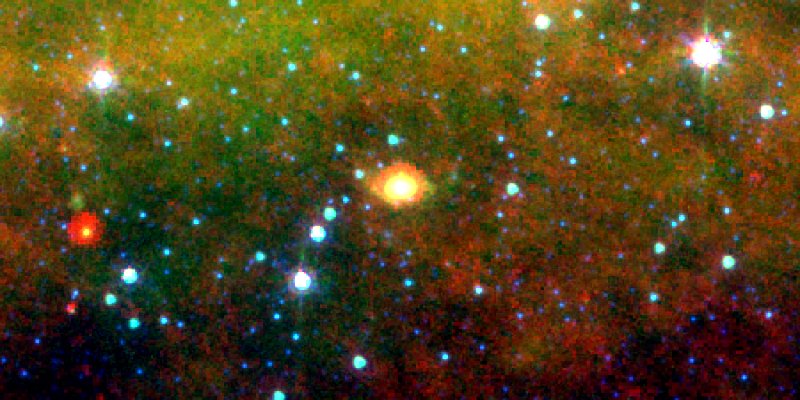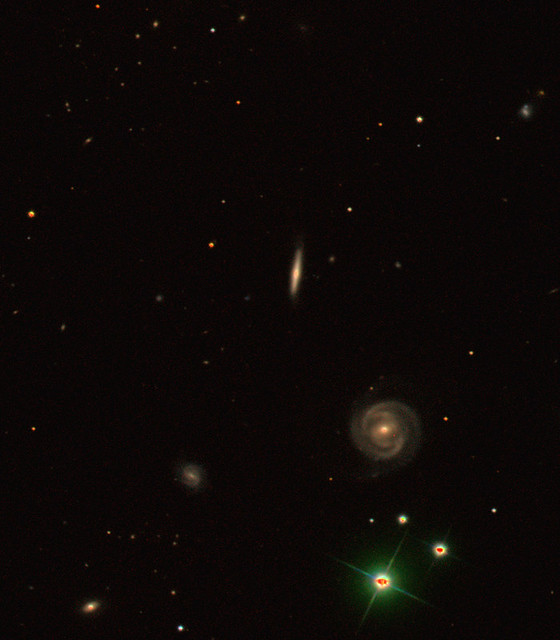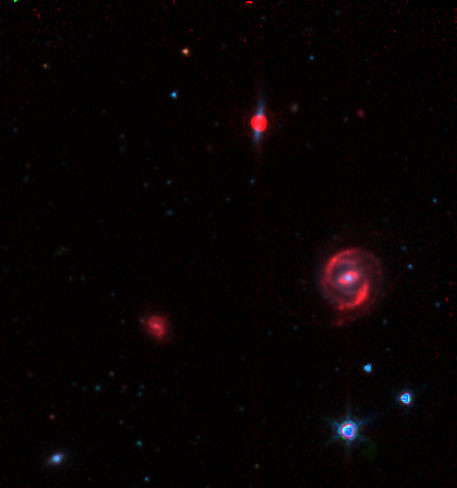Is this a lensed galaxy? / red ring (8µm)
-
 by
Melina_t
by
Melina_t

This is a elliptical galaxy some volunteers found in the Milky Way Project. I did process the spitzer-raw data into this image.
Here is the infromation from GLADE: http://vizier.u-strasbg.fr/viz-bin/VizieR-5?-ref=VIZ5887264f8937&-out.add=.&-source=VII/275/glade1&recno=53924I don't know what the red ring (8µm) is. I thought it is maybe a lensed background galaxy. Sadly there is no SDSS, because it is in a busy part of the milky way. @researchers
Posted
-
 by
zoob1172
by
zoob1172
FIGURE 15 http://ned.ipac.caltech.edu/level5/Sept11/Buta/Buta6.html
Posted
-
 by
Melina_t
in response to zoob1172's comment.
by
Melina_t
in response to zoob1172's comment.
Thank you for the link. The ring is in fact inside the galaxy, so it is not a outer ring. Maybe a nuclear ring?
From the Milky Way project:
The GLIMPSE 8 µm wavelength shows emission from Polycyclic Aromatic Hydrocarbons (PAHs), which are small molecules excited by strong ultraviolet radiation from massive hot stars. These molecules exist in the surface layers of dense molecular clouds. So this PAH emission is a signpost of recent high-mass star formation, which requires molecular clouds to form in.
I used 3.6 µm for blue, 4.5 µm for green and 8.0 µm for red. Spiral arms and bar are usually visible at 8.0 µm.
Posted
-
 by
Budgieye
moderator
by
Budgieye
moderator
I think that is absolutely amazing.
But lensed arcs do not look flattened like that. They are always circular features around a center of mass. There are searches being done for buried red rings. But I should ask a lens scientist to look in, just to be sure.
3.9 Gravitational lenses https://talk.galaxyzoo.org/#/boards/BGZ0000001/discussions/DGZ0000wrb?page=3
If it is flattened with perspective, it must be part of the galaxy. Maybe a nuclear ring?
2.2 Nucleus, nuclear bulge, and bulgeless, X-shaped bulges , nuclear rings https://talk.galaxyzoo.org/#/boards/BGZ0000001/discussions/DGZ0000wrb?page=2
I can't find an example about a nuclear ring inside an elliptical galaxy. I think time for a scientist.
It is great how you have brought up the red colour in the galaxy. There is nothing much to see in the PanSTARRS image.

Spitzer..8 µm.................PanSTARRS in colour...............PansSTARRS infrared y band 9633Å
8 µm is 80000 Å. I must say that I don't know much about infrared astronomy.
Nothing much in NED, NASA's Extragalactic Database. No references published yet, though someone seems to accumulating data in infrared.
1 2MASX J22352646+6048150
2 SSTSL2 J223526.23+604805.9
3 SSTSL2 J223527.51+604808.1
4 SSTSL2 J223525.75+604831.4
5...
series continues with many Infrared sources.http://ned.ipac.caltech.edu/cgi-bin/objsearch?
in_csys=Equatorial&in_equinox=J2000.0&lon=22+35+26.4&lat=60+48+15.0&radius=2.0&hconst=73&omegam=0.27&omegav=0.73&corr_z=1&search_type=Near+Position+Search&z_constraint=Unconstrained&z_value1=&z_value2=&z_unit=z&ot_include=ANY&nmp_op=ANY&out_csys=Equatorial&out_equinox=J2000.0&obj_sort=Distance+to+search+center&of=pre_text&zv_breaker=30000.0&list_limit=5&img_stamp=YESObject is too small to show much in WISE http://irsa.ipac.caltech.edu/applications/wise/#id=Hydra_wise_wise_1&dpLevel=3a&DoSearch=true&schema=allsky-4band&intersect=CENTER&subsize=0.16666666800000002&mcenter=mcen&band=1,2,3,4&optLevel=3a&UserTargetWorldPt=338.860333;60.804222;EQ_J2000&TargetPanel.field.targetName=2MASX J22352646%2B6048150&SimpleTargetPanel.field.resolvedBy=nedthensimbad&coaddId=&projectId=wise&searchName=wise_1&startIdx=0&pageSize=0&shortDesc=Position&isBookmarkAble=true&isDrillDownRoot=true&isSearchResult=true
Posted
-
 by
Melina_t
by
Melina_t
I did create a list of spitzer infrared-galaxies. Here is the link: spitzer galaxies.
In the list there are 59 galaxies with 35 new candidates. Most of them are spiral galaxies and many are edge-on. The galaxy with the red ring is number 37. I could not find a second galaxy with a similar ring. You can see how prominent the ring is at 8 μm, compared to the shorter wavelengths.
The galaxy with the red ring is also a radio source. Here is the source in NED: 2MASX J22352646+6048150.By the way: I said it is an elliptical galaxy, but this is only a guess. But the galaxy is quite red in PanSTARRS.
Posted
-
 by
drphilmarshall
scientist
by
drphilmarshall
scientist
I think @Budgieye is right, it's not a lens. Good to check in the radio too, @Melina_t, I was just thinking that the Spitzer image looked like it might show an AGN in the center of the galaxy - perhaps that's why it appears as a radio source as well.
Posted
-
Looks like a WISE AGN signature to me, not listed as AGN in SIMBAD or VizieR.
Posted
-
Looks more 'intense' to one side but I presume that is perspective? That side is closer to us?
Also maybe some faint spiral structure / tidal debris further out it seems (also Spitzer 8µm).

Great find and image processing btw, very cool such a (unseen) ring structure!
Posted
-
 by
Budgieye
moderator
in response to drphilmarshall's comment.
by
Budgieye
moderator
in response to drphilmarshall's comment.
Thank you Dr Phil Marshall
Posted
-
 by
Budgieye
moderator
in response to drphilmarshall's comment.
by
Budgieye
moderator
in response to drphilmarshall's comment.
BTW everyone the @ command does not work in this version of Talk, but I think we will be upgraded sometime.
Posted
-
 by
Budgieye
moderator
in response to Melina_t's comment.
by
Budgieye
moderator
in response to Melina_t's comment.
Dear Melina, what is your candidate list trying to find?
Posted
-
 by
Budgieye
moderator
in response to Melina_t's comment.
by
Budgieye
moderator
in response to Melina_t's comment.
Elliptical galaxies have hidden mysteries. There are movements of streams of stars inside, so an elliptical galaxy can be a blend of two or three galaxies swirling independently. See the MaNGA project.
7.1 Spectral Charts, MaNGA https://talk.galaxyzoo.org/#/boards/BGZ0000001/discussions/DGZ0000wrb?page=7
Posted
-
 by
Melina_t
in response to Budgieye's comment.
by
Melina_t
in response to Budgieye's comment.
I did process a lot of galaxies that the volunteers of the milky way project pointed out. Only this way I was able to find the red ring. The galaxy looks in the milky way project like this:

I wanted to point out that spitzer only shows this one galaxy with a ring and that there are some good candidates that are not in NED, like number 1, 24, 31, 41, 44, 50, 52, 54. It seems like someone began to list spitzer galaxies in NED, but did not finish this work. One galaxy is called GLIMPSE:[JKK2007] G1 (spitzer does have different surveys, like GLIMPSE, CYGNUS-X, SMOG and MIPSGAL) and others are called [MNP2008], which is a spitzer list of 25 galaxies ([MNP2008] Spitzer).
So you can say that the list did help me to find the galaxy with the red ring. The list does show only galaxies that were found in the milky way project, while the milky way project is creating a bubble catalog and a bowshock catalog.
Posted
-
 by
mlpeck
in response to Melina_t's comment.
by
mlpeck
in response to Melina_t's comment.
I'm afraid I have no resources at hand at the moment and won't for a few days, but I distinctly remember creating a false color composite of Spitzer imaging of the galaxy HCG 71a (aka NGC 5008, etc.) that has a striking circumnuclear ring that really lights up at 8μm. That is a face on barred spiral in a compact group (hence the catalog designation). It also has an AGN and may be interacting with other members of the group although morphological evidence is pretty subtle. The reference for the paper describing the investigation is http://adsabs.harvard.edu/cgi-bin/bib_query?2010A%26A...517A..75B. I believe Bitsakis was the PI on the observing proposal.
Posted
-
 by
Melina_t
in response to mlpeck's comment.
by
Melina_t
in response to mlpeck's comment.
NGC 5008 does really have a similar nuclear ring at 8.0 μm. Thank you @mlpeck .
Here both galaxies. Left is only 8.0 μm and right is the RGB with i1/i2/i4.
2MASX J22352646+6048150


NGC 5008


Both rings are good visible at i4 (8μm) and for 2MASX J22352646+6048150 you can see it fainter at i3 (5.8μm). i1 (3.6μm) and i2 (4.5μm) does not show a clear ring.
Posted
-
 by
Budgieye
moderator
by
Budgieye
moderator
I'll call on another scientist to have a look.
Posted
-
 by
Budgieye
moderator
by
Budgieye
moderator
Request from scientist: might be any images at other wavelengths, like K-band? If it's that bright it might get through the MW absorption at NIR wavelengths.
Posted
-
 by
Budgieye
moderator
by
Budgieye
moderator
Red ring not visible in
2MASS: H: 1999-09-30
2MASS: J: 1999-09-30
2MASS: K: 1999-09-30
Posted
-
 by
Melina_t
by
Melina_t
I could only find the ring in two spitzer images. The weak emmision of PanSTARRS r could fit the size of the ring to one side. But no clear ring is visible:

I also looked at 2MASS and other surveys but no luck. UKIDSS does not cover this area and IPHAS does not show a ring.
Posted
-
 by
mlpeck
in response to Budgieye's comment.
by
mlpeck
in response to Budgieye's comment.
Now that I'm back home --
strong emission at 8μm in Spitzer images is usually attributed to complex molecules called PAH's, which depending on your point of view are either really small dust grains or really large molecules. There's also a PAH band at ∼5μm, I think. So, if a region of a galaxy is bright at 5-8μm and not so bright at shorter wavelengths you're probably looking at star forming molecular clouds. The OP and the post right above reminded me a lot of some images I prepared of the Hickson Compact Group 71 a few years ago.
Here are a couple. First a "deep" SDSS g,r,i band image (by deep I just mean I used a stretch that emphasized low surface brightness regions of the image):
This was prepared from the r,i,z band images:
The beautiful barred spiral in the lower right is HCG 71a, the edge on galaxy to the north is HCG 71b, and the smaller spiral to the left is HCG 71c. The 4th member in the original catalog is actually a background galaxy; that's the one at lower left near the edge of the frame. There are also 2 other fainter group members to the north that were never cataloged as such.
Finally, here's a Spitzer image combining channels 1,2, and 4:
What looks to me like a nearly complete ring in the inner part of HCG 71a appears to outline the outer edge of the bar, and the most vigorously star forming areas in the spiral arms also light up red.
HCG 71b was actually the original object of interest. The Spitzer image suggests that it's undergoing a very intense centrally concentrated starburst that's not at all evident in the SDSS spectrum or imaging.
Anyway, I'm guessing a deeper IR image would show the object in the OP to be a disk galaxy.
Posted
-
 by
mlpeck
in response to mlpeck's comment.
by
mlpeck
in response to mlpeck's comment.
Posted
-
Does the IR image of Andromeda count as a ring?
Posted
-
 by
Astro_Denny
by
Astro_Denny
Interesting object, and interesting discussion. It seems to me that the ring is more likely an "inner ring" than a far beyond lensed galaxy. So far, all lensed galaxie images I´ve seen are generally formed due to clusters of galaxy ( I don´t know if the galaxy in question, although elliptical, has such an immense mass, hence gravity, to lense something), and are also formed (as far as I´ve seen) at the periphery of the gravitational lense, not quite in the middle. Anyway, if I´m wrong and anyone has some examples of one-galaxy lensing or non-peripheral lensing, I would appreciate if you´ll post them.
Posted
-
Hi Astro_Denny,
AFAIK gravitational lenses occur on the scale of clusters (arcs =. partial Einstein rings) and individual galaxies (arcs, complete rings and Einstein cross = 4 images of background galaxy) . Mostly ellipticals but also (at least) 1 spiral galaxy lensing a background galaxy with the mass of its nucleus into an Einstein cross.
Short on time atm sorry, maybe check The Index by Budgieye here in the sticky threads.
Posted
-
 by
Budgieye
moderator
by
Budgieye
moderator
Scientists will be looking at this thread soon.
Posted
-
 by
Melina_t
by
Melina_t
I started a discussion in the Milky Way Project about possible circumstellar nebulae or galaxies.
Subject 2304663 also does show a ring. It is the galaxy 2MASX J22243353+6042529.
Another object that is not classified as a galaxy, but could be a galaxy with a ring is Subject 2367442 (MGE 322.7707-00.2829), because it shows extended emissions at I1 and I2:

They are faint rings compared to 2MASX J22352646+6048150.
Posted
-
 by
Budgieye
moderator
by
Budgieye
moderator
Ring Found Around a Galaxy’s “Hidden” Black Hole
Not this one.
Posted
-
 by
Melina_t
in response to Budgieye's comment.
by
Melina_t
in response to Budgieye's comment.
I have read the article in the link. Our ringed galaxy might have an AGN (see previous post by @drphilmarshall ). So maybe it is also a recent merger?
Posted
-
 by
vrooje
admin, scientist
by
vrooje
admin, scientist
Hi all,
As an update: this post has been shared with the team and also with a couple of people outside the team. One of them is a scientist who works on modelling the way AGN-triggered star formation happens in a galaxy. Some simulations show an AGN can trigger an expanding ring of star formation that works its way outward through the galaxy and then quenches behind it as the AGN continues to heat up the gas in the galaxy. This could be an example of such a phenomenon.
The main challenge is the line of sight to this galaxy -- it's very hard to get much other information about it! Even just a redshift would be helpful, but we don't seem to have one and our usual optical tricks won't really work. It's also not clear to me how rare this really is; others have found other examples, and I'm really not sure whether this is just one more in a long string or whether this subset of galaxies is rare enough that this is really notable. That's most likely because I'm just not intimately familiar with this particular sub-field of AGN feedback.
But hopefully this info is now in the hands of the right people... the work in this thread is awesome, everyone! 😃
-Brooke
Posted


